Introduction
- Protecting children is the police’s responsibility.
- Preparing a pre-inspection project.
- Identifying potential risk areas.
- Determining the methods of communication with stakeholders.
- Assessing the principles of inspection.
- Preparing a work breakdown structure and Gantt chart.
To prepare the Abu-Dhabi police for inspection, a preliminary inspection project should be organized. Potential risks will be reviewed to determine the key areas of work. Identifying stakeholders and how to interact with them will help create a clear communication framework. Inspection principles will be identified, and a work breakdown structure and Gantt chart will be compiled.
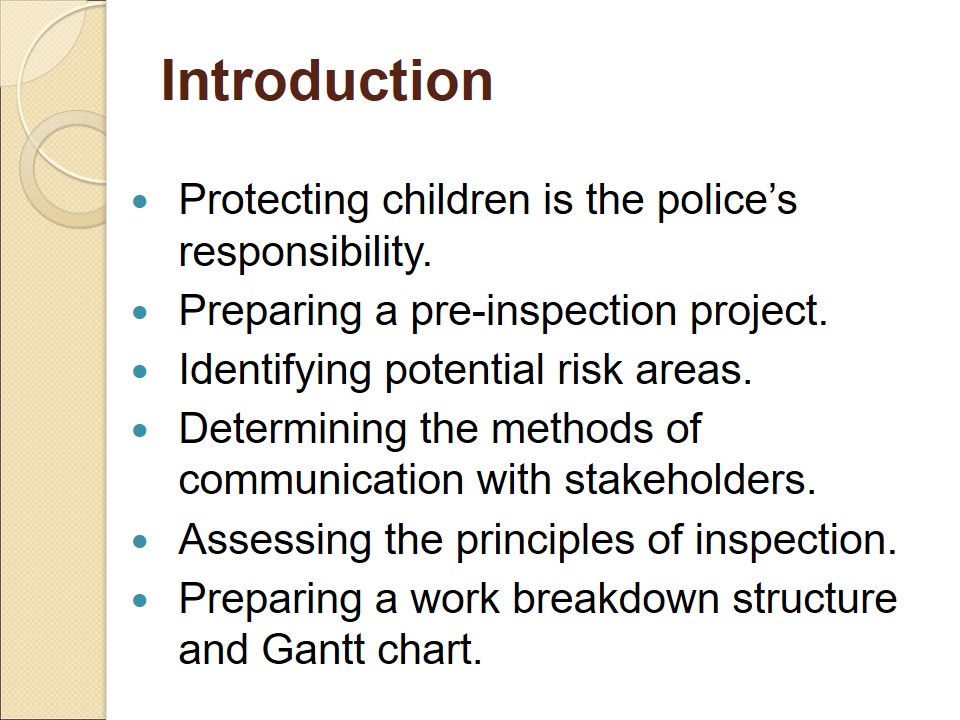
Identifying Risks
- Vulnerable children are identified.
- Behavioral patterns are compared (“National Child Protection Inspection Programme,” 2020a).
- Different boards are engaged.
- Data about alleged offenses are collected (“National Child Protection Inspection Programme,” 2020b).
- Local statistics and reports are utilized.
Timely risk identification is imperative for the full protection of children by the police. Specific cases need to be identified based on local reports and statistical assessments. The real data of alleged offenses are to be compiled by utilizing various services. Based on this information, the characteristic behavioral patterns of abuse should be emphasized.
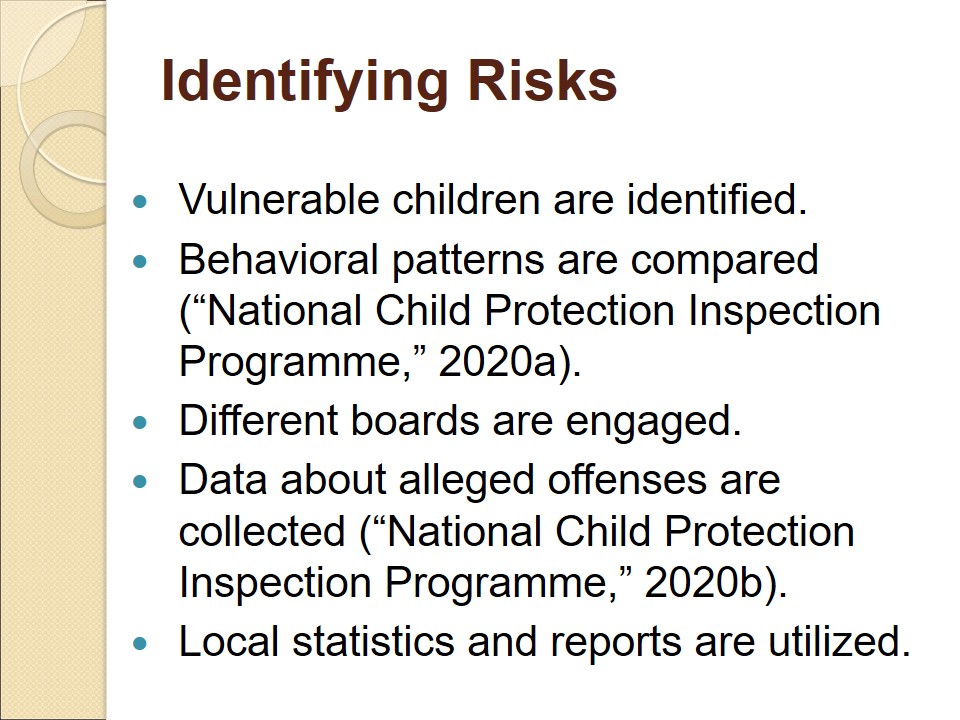
Risk Areas
- Children at risk of harm.
- Domestic abuse (“National Child Protection Inspections,” 2018).
- Child sexual exploitation (“National Child Protection Inspections,” 2018).
- The risks of parental neglect.
- Involvement in criminal activities.
- Guardianship issues (“National Child Protection Inspection Programme,” 2020b).
A number of risk areas deserve attention in the planned inspection project. Different categories of threats need to be considered, including domestic abuse, parental neglect, sexual exploitation, criminal involvement, and guardianship issues. Identifying risk situations is imperative to provide comprehensive assistance to the target audience and eliminate threats to the child population of the UAE.
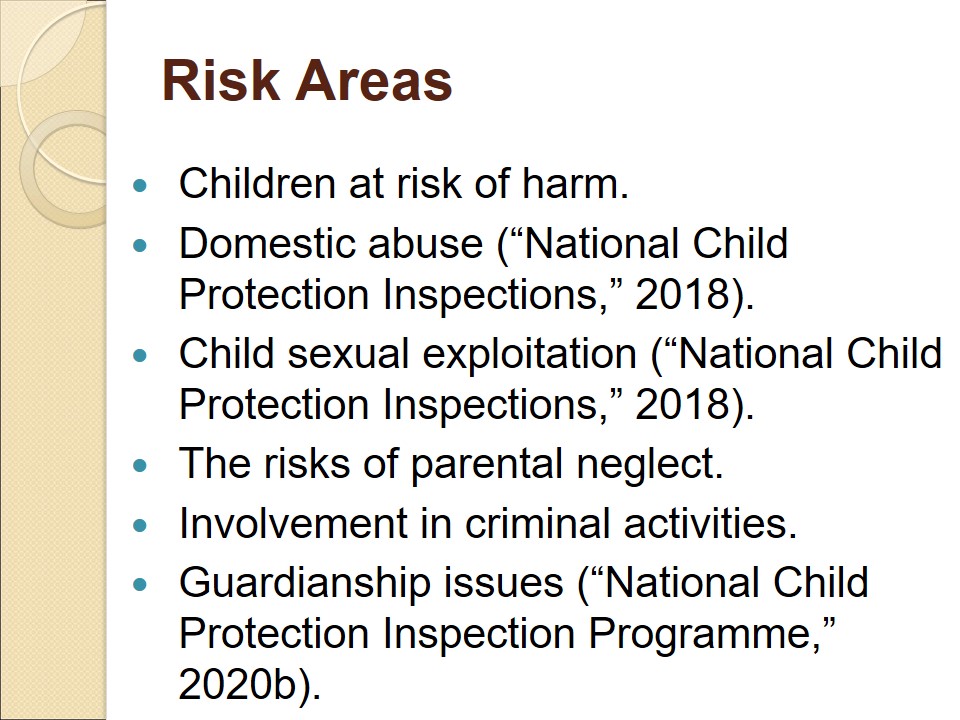
Steps to Manage Risks
- Engaging different stakeholders.
- Allocating the necessary resources.
- Creating individual police units (“National Child Protection Inspections,” 2018).
- Building appropriate work algorithms.
- Maintaining collaboration with health and social services.
- Creating a stable reporting system.
- Timely responses to offenses.
- A vertical control system.
- Disseminating the information among communities.
- The systematization of the collected data.
- “Multi-agency risk assessment conferences” (“National Child Protection Inspections,” 2018, p. 10).
Determining the steps to effectively manage the aforementioned risks areas requires a variety of resources and adequate interventions. In addition to multiple stakeholders, such as health and social services, reasonable resource allocation, including control over the workforce, is needed. Individual police units should be created to carry out targeted work, and a stable reporting system should be maintained.
Risk management includes not only stakeholder engagement but also internal initiatives to apply in the Abu-Dhabi police departments. Special conferences and a vertical reporting system can help disseminate the information about children’s issues, and community education is a valuable initiative. The data collected during teamwork need to be systematized to get a comprehensive picture and have a rational background for making relevant steps.

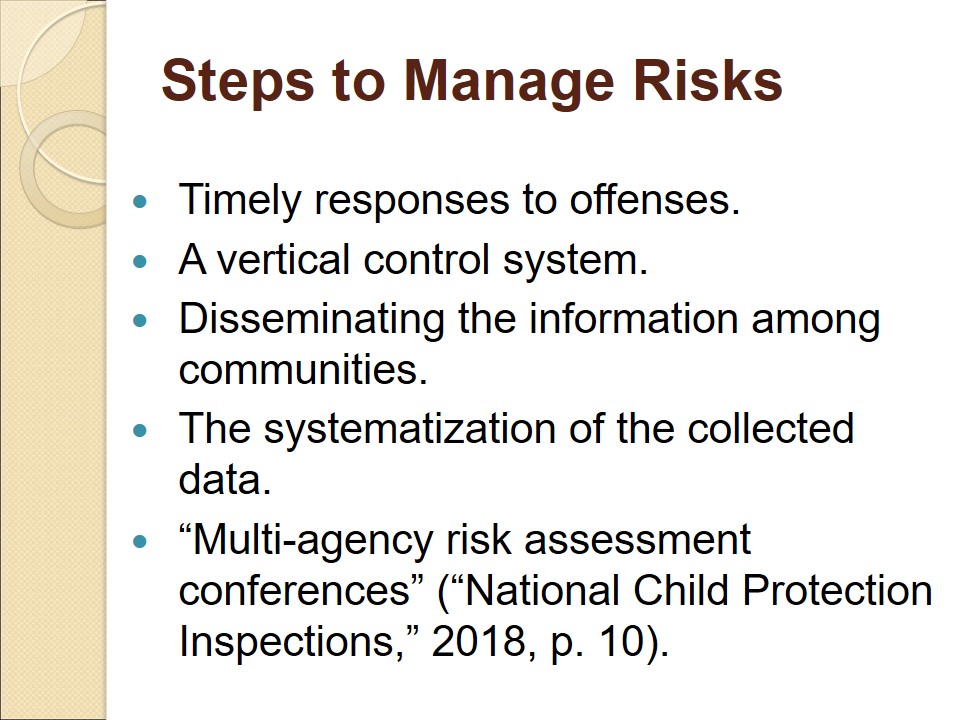
Importance of Communication with Stakeholders
- Communication is a crucial measure.
- Different stakeholders provide distinctive data.
- “Interpreters, intermediaries, trusted mental health professionals” (“National Child Protection Inspection Programme,” 2020a, para. 15).
- Various areas are involved.
- Children’s safety is a collective task.
Communication with different stakeholders is an important aspect of the pre-inspection project under consideration. Interested parties from different fields have distinctive data that can provide a wide range of valuable knowledge. Moreover, ensuring the safety of children is not only the task of police units but also of other social services, including healthcare, education, and child legislation.
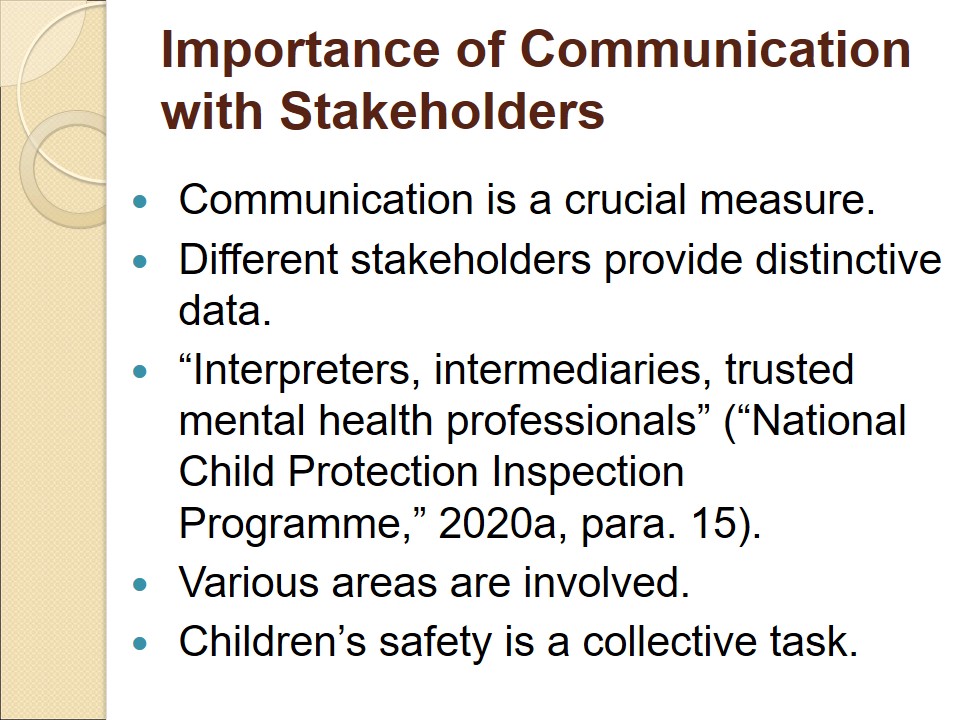
Methods of Communication with Stakeholders
- Providing children at risk with survey checklists (Featherstone et al., 2018).
- Organizing community meetings.
- Creating online communities on social media.
- Direct contact with social services.
- Request for statistical reports.
- Holding meetings with dysfunctional families.
To interact with various stakeholders, different methods can be used. Communication with vulnerable children and dysfunctional families can take place both individually and at community meetings. The dissemination of the necessary information on online sites, for instance, social media, is a potentially powerful mechanism. Interaction with social services through business correspondence and statistical data requests is a mandatory procedure to follow.
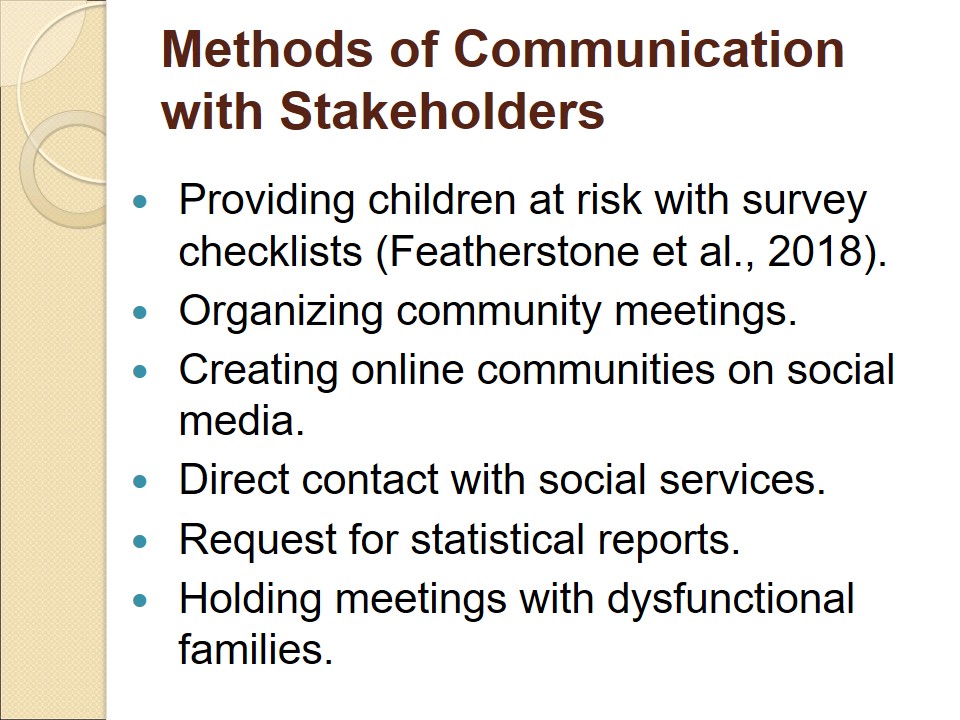
Evaluating/Auditing the Current Child Protection Standards
- Reviewing the current legislative framework.
- Checking officers’ theoretical preparedness.
- Analyzing the availability of the resource base.
- Control over the activities of ADP departments’ heads.
- The assessment of the results of targeted work over the past year.
A preliminary audit involves several important steps to be taken. Firstly, this is crucial to assess the preparedness of the officers and heads of ADP units and their knowledge of the legislative basis. The evaluation of the resource base should be carried out to identify potential gaps or deficiencies. To determine specific outcomes, the results of targeted work with the child population are to be analyzed over the past year, and specific indicators should be emphasized to be corrected in the future.
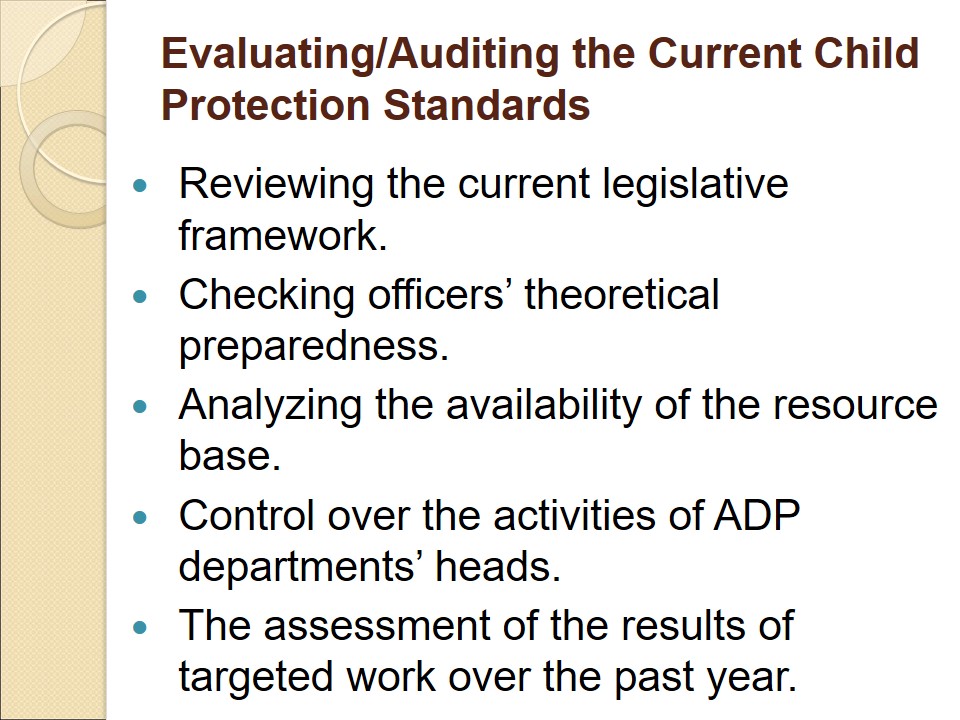
Work Breakdown Structure
The presented work breakdown structure (WBS) is a scheme reflecting all the necessary procedures to perform within the scope of the planned pre-inspection project. The three main activities (testing theoretical preparedness, checking the resource base availability, and control over ADP heads) are complemented by the accompanying tasks and the variables to assess.
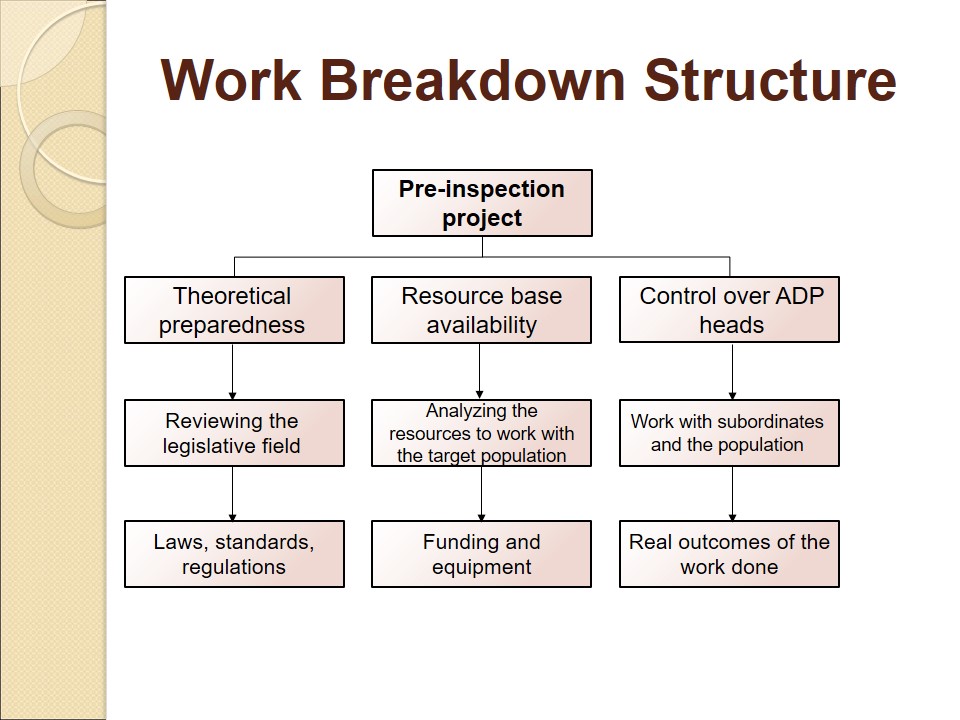
Gantt Chart
The presented Gantt chart reflects the schedule of the key goals to be realized within the framework of the pre-inspection project under consideration. The aforementioned three main activities will be completed within six months prior to the start of the official inspection. To begin with, the theoretical training of the officers involved needs to be tested, and appropriate assessments will be performed at intervals of one month. In the second month, the analysis of the resource base needs to start, and this stage will last three months and will end with the inspection itself in the sixth month. Finally, control over the activities of ADP heads will take three months of due diligence in the middle of the entire period to train chief officers comprehensively.
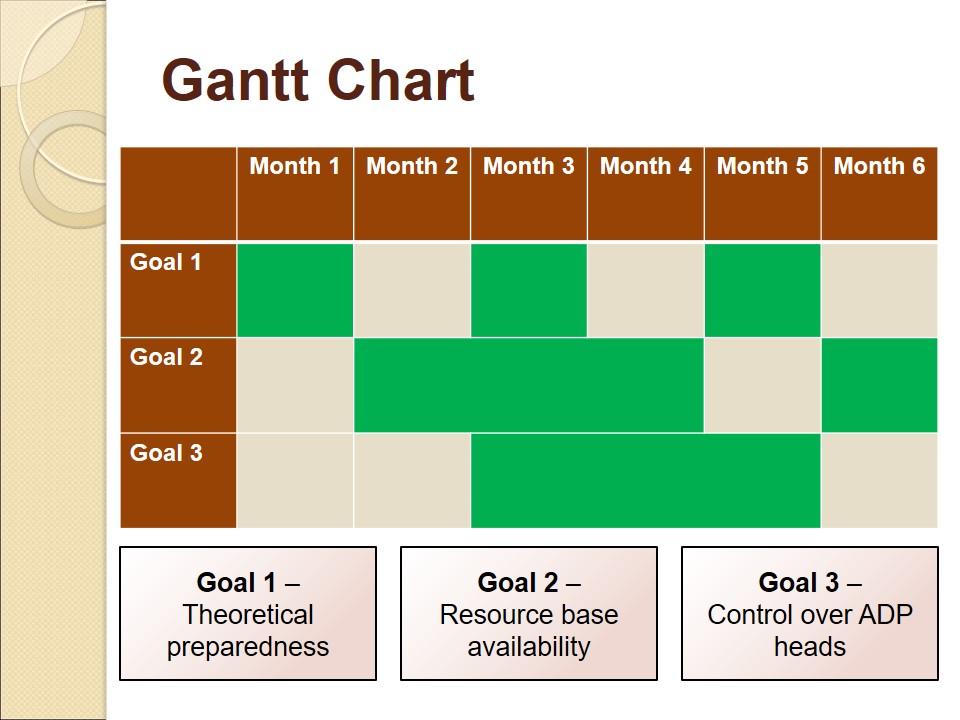
Project Overview
- The planned project is the pre-inspection audit in ADP.
- The main goals include testing the units’ preparedness to working in the child protection area.
- Among the risks, one should identify domestic abuse, sexual exploitation, parental neglect, and some other threats.
- Engaging relevant stakeholders is a critical task to check the readiness to help the target population and join forces.
- Social services, healthcare boards, legislators, policymakers, and some other stakeholders may be engaged.
- Various methods of communication with interested parties may be applied, including real-time meetings and remote interaction.
- The main tasks to perform are testing officers’ theoretical preparedness, checking the resource base, and monitoring ADP heads’ activities.
- A work breakdown structure (WBS) and Gantt chart are convenient mechanisms to describe the stages of work and timeline.
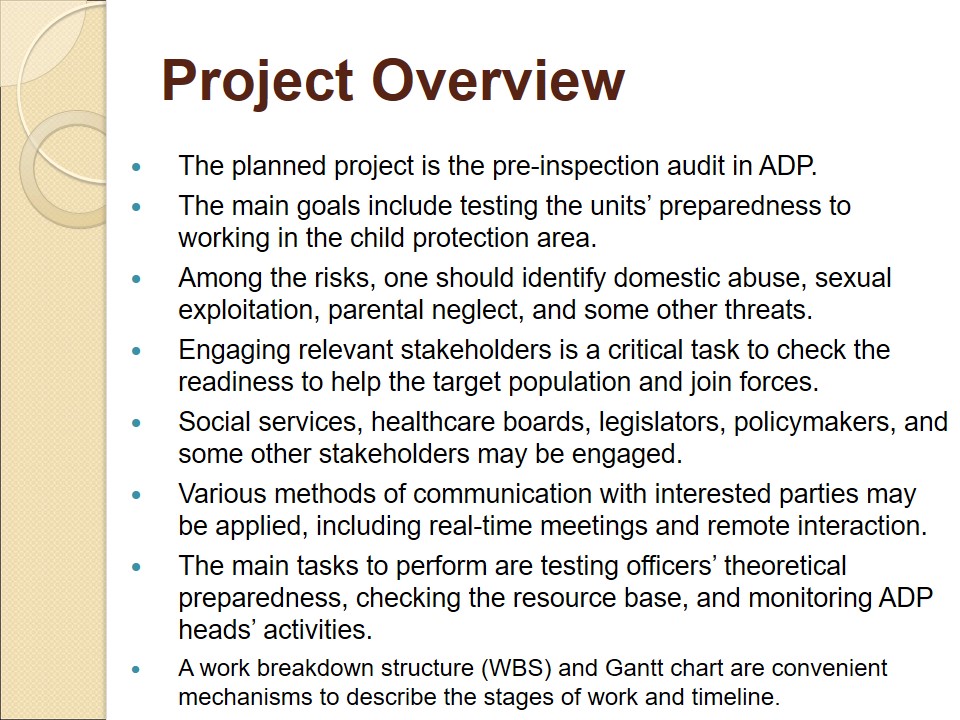
References
Featherstone, A. M., Barnes, G., & O’Connor, D. (2018). Can police prioritize highest risks of harm among 6670 children exposed to domestic abuse?Cambridge Journal of Evidence-Based Policing, 2(3-4), 111-124. Web.
National Child Protection Inspections. (2018). Her Majesty’s Inspectorate of Constabulary and Fire & Rescue Services. Web.
National Child Protection Inspection Programme – Assessment criteria. (2020a). Her Majesty’s Inspectorate of Constabulary and Fire & Rescue Services. Web.
National Child Protection Inspection Programme – Child protection inspection methodology. (2020b). Her Majesty’s Inspectorate of Constabulary and Fire & Rescue Services. Web.